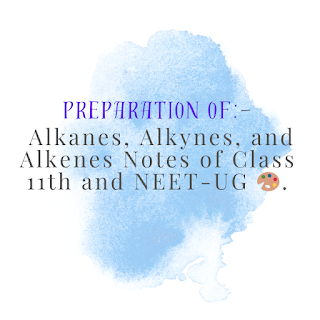Hydrocarbons: A Perfect Notes of Alkanes, Alkynes, and Alkenes for Class 11th and NEET-UG
Introduction:
Welcome to the exciting world of hydrocarbons, where carbon and hydrogen dance together to create a myriad of compounds. In this beginner-friendly guide, we'll explore the step-by-step process of preparing alkanes, alkynes, and alkenes, spiced up with easy-to-understand examples.
1. Alkanes: The Simple Saturations
Alkanes are like the chillers of the hydrocarbon family, keeping it simple with single carbon-carbon bonds. Imagine turning an unsaturated pal into a laid-back saturated friend - that's hydrogenation!
Example: Transforming Ethene into Ethane
Here, ethene (C₂H₄) kicks back with hydrogen (H₂) using a platinum (Pt) catalyst, becoming ethane (C₂H₆), a relaxed saturated alkane.
2. Alkynes: The Triple Action Heroes
Meet alkynes, the hydrocarbons with a bit of spice - carbon-carbon triple bonds. Let's transform a double-bonded duo into a triple-bonded trio through dehydrohalogenation!
Example: Turning Dibromoethane into Acetylene
Heating up 1,2-dibromoethane (CH₂Br-CH₂Br) with sodium amide (NaNH₂) transforms it into acetylene (HC≡CH), bringing that triple bond swagger.
3. Alkenes: The Double Trouble Makers
Alkenes, with their carbon-carbon double bonds, add a dash of drama. Picture removing water from an alcohol - that's dehydration leading to alkene formation!
Example: Dehydrating 2-Propanol into Propene
By using sulfuric acid (H₂SO₄) as a catalyst, 2-propanol [(CH₃)₂CHOH] loses water and transforms into propene [(CH₃)₂C=CH₂], ready to stir things up
.png)

.png)

.png)
